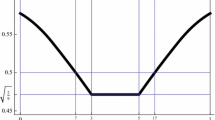Abstract
Let f 1 and f 2 be two positive numbers of the field \( K = \mathbb{Q}(\sqrt 5 ) \), and let f n+2 = f n+1 + f n for each n ≥ 1. Let us denote by {x} the fractional part of a real number x. We prove that, for each ξ ∉ K, the inequality {ξf n } > 2/3 holds for infinitely many positive integers n. On the other hand, we prove a result which implies that there is a transcendental number ξ such that {ξf n } < 39/40 for each n ≥ 1. Moreover, it is shown that, for every a > 1, there is an interval of positive numbers that contains uncountably many numbers ξ such that {a n} 6 min 2/(a − 1), (34a 2 − 32a + 7)/(9(2a − 1)2) for each n > 1. Here, the minimum is strictly smaller than 1 for each a > 1. In contrast, by an old result of Weyl, for any a > 1, the sequence {ξa n}, n = 1, 2, ..., is uniformly distributed in [0, 1] (and so everywhere dense in [0, 1]) for almost all real numbers ξ.
Similar content being viewed by others
References
S. D. Adhikari and P. Rath, A problem of the fractional parts of the powers of 3/2 and related questions, Proceedings of a Number Theory Conference held in Chandigarh, 2005, to appear.
S. D. Adhikari, P. Rath and N. Saradha, On the sets of uniqueness of the distribution function of ξ (p/q) n}, Acta Arithmetica 119 (2005), 307–316.
R. K. Akhunzhanov and N. G. Moshchevitin, On the chromatic number of a distance graph associated with a lacunary sequence (in Russian), Rossiiskaya Akademiya Nauk, Doklady Akademii Nauk 397 (2004), 295–296.
S. Akiyama, C. Frougny, J. Sakarovitch, On the representation of numbers in a rational base, in Proceedings of Words 2005 (S. Brlek, Ch. Reutenauer, eds.), Monographies du LaCIM 36, UQaM, Montréal, Canada, 2005, pp. 47–64.
Y. Bugeaud, Linear mod one transformations and the distribution of fractional parts {(p/q) n}, Acta Arithmetica 114 (2004), 301–311.
Y. Bugeaud and A. Dubickas, Fractional parts of powers and Sturmian words, Comptes Rendus Mathé matique, Académie des Sciences Paris, Serie I 341 (2005), 69–74.
J. W. S. Cassels, An Introduction to Diophantine Approximation, Cambridge University Press, Cambridge, 1957.
B. de Mathan, Numbers contravening a condition in density modulo 1, Acta Mathematica Hungarica, Academia Kiadó 36 (1980), 237–241.
A. Dubickas, Arithmetical properties of powers of algebraic numbers, Bulletin of the London Mathematical Society 38 (2006), 70–80.
A. Dubickas, On the distance from a rational power to the nearest integer, Journal of Number Theory 117 (2006), 222–239.
A. Dubickas, Even and odd integral parts of powers of a real number, Glasgow Mathematical Journal 48 (2006), 331–336.
A. Dubickas, On the fractional parts of lacunary sequences, Mathematica Scandinavica 99 (2006), 136–146.
A. Dubickas, On the powers of 3/2 and other rational numbers, Mathematische Nachrichten 281 (2008), 951–958.
P. Erdős, Problems and results on Diophantine approximations. II, Repartition modulo 1, Actes Colloq. Marseille-Luminy 1974, Lecture Notes in Math. 475 (1975), 89–99.
L. Flatto, J. C. Lagarias and A. D. Pollington, On the range of fractional parts {ξ (p/q) n}, Acta Arithmetica 70 (1995), 125–147.
Y. Katznelson, Chromatic numbers of Cayley graphs on ℤ and recurrence, Combinatorica 21 (2001), 211–219.
J. F. Koksma, Ein mengentheoretischer Satz über Gleichverteilung modulo eins, Compositio Mathematicae 2 (1935), 250–258.
K. Mahler, An unsolved problem on the powers of 3/2, Journal of the Australian Mathematical Society 8 (1968), 313–321.
A. D. Pollington, On the density of the sequence {n k ξ}, Illinois Journal of Mathematics 23 (1979), 511–515.
I. Z. Ruzsa, Zs. Tuza and M. Voigt, Distance graphs with finite chromatic number, Journal of Combinatorial Theory, Series B 85 (2002), 181–187.
R. Tijdeman, Note on Mahler’s 3/2-problem, K. Norske Vidensk. Selsk. Skr., 16 (1972), 1–4.
T. Vijayaraghavan, On the fractional parts of the powers of a number. I, Journal of the London Mathematical Society 15 (1940), 159–160.
H. Weyl, Über die Gleichverteilung von Zahlen modulo Eins, Mathematische Annalen 77 (1916), 313–352.
T. Zaimi, An arithmetical property of powers of Salem numbers, Journal of Number Theory 120 (2006), 179–191.
Author information
Authors and Affiliations
Corresponding author
Rights and permissions
About this article
Cite this article
Dubickas, A. An approximation property of lacunary sequences. Isr. J. Math. 170, 95–111 (2009). https://doi.org/10.1007/s11856-009-0021-1
Received:
Revised:
Published:
Issue Date:
DOI: https://doi.org/10.1007/s11856-009-0021-1



